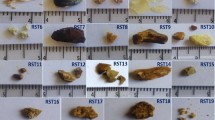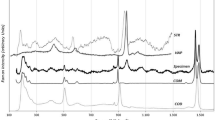Abstract
Purpose
To evaluate urinary stones using small-angle X-ray scattering (SAXS) and nitrogen porosimetry (NP). Traditionally, stones are categorized as hard or soft based on their chemical composition. We hypothesized that stone hardness is associated not only with its chemical composition but also with its internal architecture. SAXS and NP are well-known techniques in material sciences. We tested whether SAXS and NP are applicable for evaluating human urinary stones and whether they provide information at the nanoscale level that could be useful in clinical practice.
Methods
Thirty endoscopically removed urinary stones were studied. Standard techniques for stone analysis were used to determine the stone composition. SAXS was used to evaluate the solid part of the stone by measuring the crystal thickness (T) and the fractal dimension (Dm/Ds), while NP was used to evaluate the porosity of the stone, i.e., the pore radius, pore volume, and specific surface area (SSA).
Results
All stones were successfully analyzed with SAXS and NP. Each stone demonstrated unique characteristics regarding T, Dm/Ds, pore radius, pore volume, and SSA. Significant differences in those parameters were seen among the stones with almost identical chemical compositions. The combination of high T, high SSA, low Dm/Ds, low pore volume, and low pore radius is indicative of a hard material and vice versa.
Conclusions
SAXS and NP can be used to evaluate human urinary stones. They provide information on stone hardness based on their nanostructure characteristics, which may be different even among stones with similar compositions



Similar content being viewed by others
Data availability
The datasets used and/or analyzed during the current study are available from the corresponding author on reasonable request.
Abbreviations
- SWL:
-
Shockwave lithotripsy
- SAXS:
-
Small-angle X-ray scattering
- NP:
-
Nitrogen porosimetry
- SEM:
-
Scanning electron microscopy
- KS:
-
Kidney stone
- FTIR:
-
Fourier-transform infrared spectroscopy
- SSA:
-
Specific surface area
- CT:
-
Computed tomography
- HU:
-
Hounsfield units
References
Dretler SP (1988) Stone fragility—a new therapeutic distinction. J Urol 139:1124–1127
Bhatta KM, Prien EL Jr, Dretler SP (1989) Cystine calculi—rough and smooth: a new clinical distinction. J Urol 142:937–940
Williams JC Jr, Saw KC, Paterson RF et al (2003) Variability of renal stone fragility in shock wave lithotripsy. Urology 61:1092–1097
Li T, Senesi AJ, Lee B (2016) Small angle X-ray scattering for nanoparticle research. Chem Rev 116:11128–11180
Barrett EP, Joyner LG, Halenda PP (1951) The determination of pore volume and area distributions in porous substances. I. computations from nitrogen isotherms. J Am Chem Soc 73:373–380
Fratzl P, Groschner M, Vogl G et al (1992) Mineral crystals in calcified tissues: a comparative study by SAXS. J Bone Miner Res 7:329–334
Zhang R, Gong H, Zhu D et al (2015) Multi-level femoral morphology and mechanical properties of rats of different ages. Bone 76:76–87
Jimenez-Palomar I, Shipov A, Shahar R et al (2015) Mechanical behavior of osteoporotic bone at sub-lamellar length scales. Front Mater 2:1–9
Babic M, Peter K, Igor B et al (2014) Prediction of the hardness of hardened specimens with a neural network. Mater Technol 48:409–414
Taniguchi N, Taniguchi S, Fujibayashi S et al (2016) Effect of pore size on bone ingrowth into porous titanium implants fabricated by additive manufacturing: an in vivo experiment. Mat Sci Eng C 5:690–701
Chen B, Penwell D, Benedetti LR et al (2002) Particle-size effect on the compressibility of nanocrystalline alumina. Phy Rev B 66(14):144101
Yoshinari T (2003) The improved compaction properties of mannitol after a moisture-induced polymorphic transition. Int J Pharm 258:121–131
Vordos N, Giannakopoulos S, Gkika DA et al (2017) Kidney stone nano-structure—is there an opportunity for nanomedicine development? BBA 1861:1521–1529
Evan AP, Willis LR, Lingeman JE et al (1998) Renal trauma and the risk of long-term complications in shock wave lithotripsy. Nephron 78:1–8
Motley G, Dalrymple N, Keesling C et al (2001) Hounsfield unit density in the determination of urinary stone composition. Urology 58:170–173
Kawahara T, Miyamoto H, Ito H et al (2016) Predicting the mineral composition of ureteral stone using non-contrast computed tomography. Urolithiasis 44:231–239
Christiansen FE, Andreassen KH, Osther SS et al (2016) Internal structure of kidney calculi as a predictor for shockwave lithotripsy success. J Endourol 30:323–326
Luo SN, Swadener JG, Ma C et al (2007) Examining crystallographic orientation dependence of hardness of silica stishovite. Phys B 399:138–142
Author information
Authors and Affiliations
Contributions
NV, SG, and ST conceived the study, participated in its design. NV, SG, JW, and EV analyzed the data. NV, SG, DB, IK, CK, and AM participated in interpretation of data, as well as in drafting the manuscript and revising it critically. All authors have read and approved the final manuscript.
Corresponding author
Ethics declarations
Conflict of interest
The authors declare that they have no competing interests.
Ethical approval
The study was approved by the institutional review board of the University Hospital of Alexandroupolis, Greece.
Electronic supplementary material
Below is the link to the electronic supplementary material.
Rights and permissions
About this article
Cite this article
Vordos, N., Giannakopoulos, S., Vansant, E.F. et al. Small-angle X-ray scattering (SAXS) and nitrogen porosimetry (NP): two novel techniques for the evaluation of urinary stone hardness. Int Urol Nephrol 50, 1779–1785 (2018). https://doi.org/10.1007/s11255-018-1961-3
Received:
Accepted:
Published:
Issue Date:
DOI: https://doi.org/10.1007/s11255-018-1961-3




